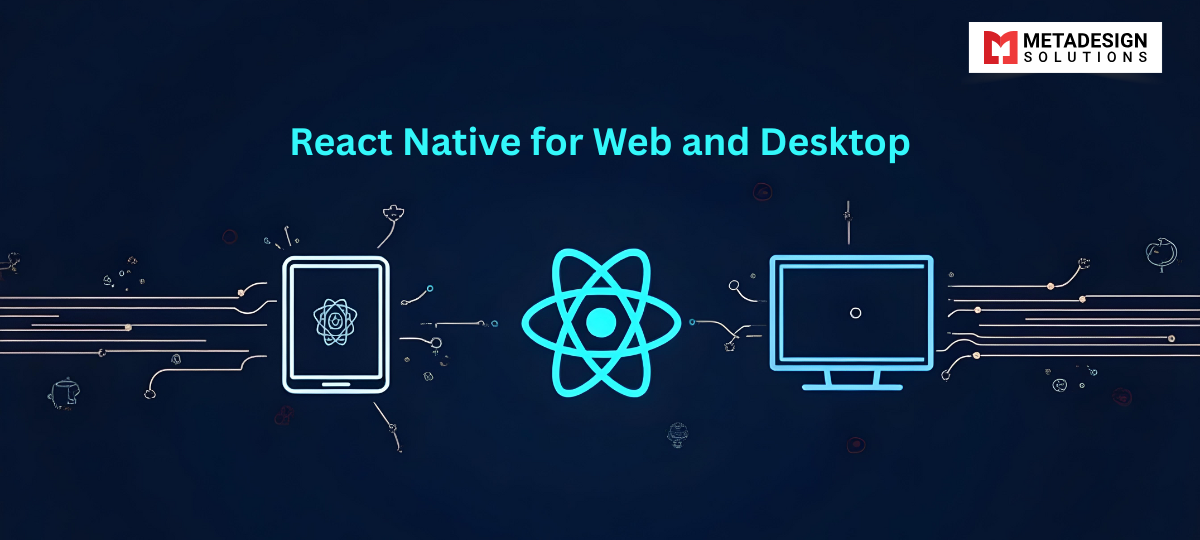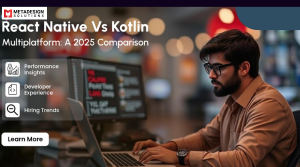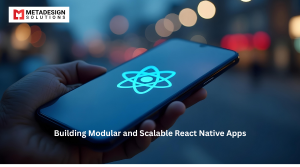React Native’s flexibility allows developers to create applications not just for mobile devices but also for web and desktop platforms. This unified development approach can save time and resources while maintaining consistency across platforms.
At MetaDesign Solutions, we’ve successfully utilized React Native to build cross-platform applications. In this blog, I’ll explore how React Native can be extended to web and desktop development, the benefits it offers, and best practices for implementation.
React Native for Web
Introduction
React Native for Web brings React Native’s component-based architecture to the browser, enabling code reuse between mobile and web platforms.
Benefits
- Code Reusability: Share components and business logic across platforms.
- Consistent User Experience: Maintain a unified look and feel.
- Faster Development: Reduce time-to-market by leveraging existing code.
Getting Started
Installation
bash code:
npm install react-native-web
Expand Your App Across Platforms
Ready to take your app beyond mobile? Schedule a consultation to explore how React Native can seamlessly extend your application to web and desktop platforms.
Configuration
- Webpack Setup: Configure Webpack to handle React Native components.
- Babel Configuration: Use Babel presets to transpile JSX and modern JavaScript features.
Example Usage
jsx code:
import React from 'react';
import { AppRegistry, View, Text } from 'react-native';
const App = () => (
<View>
<Text>Hello, Web!</Text>
</View>
);
AppRegistry.registerComponent('App', () => App);
AppRegistry.runApplication('App', { rootTag: document.getElementById('root') });
Considerations
- Platform-Specific Code: Handle differences in UI and functionality between web and mobile.
- Accessibility: Ensure web accessibility standards are met.
- SEO Optimization: Implement server-side rendering if necessary.
React Native for Desktop
Introduction
Efforts like React Native Windows and React Native macOS extend React Native to desktop platforms, allowing developers to build native desktop applications.
Benefits
- Native Performance: Utilize native desktop UI components.
- Unified Codebase: Share code across mobile, web, and desktop.
- Expanded Reach: Access users on various platforms with minimal additional effort.
Getting Started with React Native Windows
Installation
bash code:
npx react-native-windows-init --overwrite
Example Usage
jsx code:
import React from 'react';
import { View, Text } from 'react-native';
const App = () => (
<View>
<Text>Hello, Windows!</Text>
</View>
);
export default App;
Getting Started with React Native macOS
Installation
bash code:
npx react-native init MyApp
cd MyApp
npx react-native-macos-init
Example Usage
jsx code:
import React from 'react';
import { View, Text } from 'react-native';
const App = () => (
<View>
<Text>Hello, macOS!</Text>
</View>
);
export default App;
Considerations
- Platform Differences: Adapt UI and functionality to suit desktop paradigms.
- Testing: Ensure compatibility and performance on desktop environments.
- Third-Party Libraries: Verify that dependencies support desktop platforms.
Best Practices for Cross-Platform Development
1. Modularize Code
- Separate platform-specific code using file extensions like .ios.js, .android.js, .web.js, .windows.js, .macos.js.
2. Use Platform Checks
jsx code:
import { Platform } from 'react-native';
if (Platform.OS === 'web') {
// Web-specific code
} else if (Platform.OS === 'windows') {
// Windows-specific code
}
3. Consistent Styling
- Utilize StyleSheet for consistent styling across platforms.
- Leverage responsive design principles.
4. Handle Navigation
- Use platform-appropriate navigation libraries (e.g., React Navigation for mobile, React Router for web).
Real-World Application at MetaDesign Solutions
We developed a productivity app that runs seamlessly on mobile, web, and desktop.
- Approach:
- Shared core logic and components.
- Adapted UI elements to match platform conventions.
- Ensured consistent branding and functionality.
- Outcome:
- Reduced development time by 40%.
- Provided a unified experience across platforms.
- Increased user engagement through accessibility.
How MetaDesign Solutions Can Assist
Our expertise in React Native’s multi-platform capabilities can help you expand your application’s reach.
Our Services:
- Cross-Platform Development: Build applications that run on mobile, web, and desktop.
- Customization: Tailor user experiences to each platform.
- Optimization: Ensure performance and compatibility.
- Maintenance and Support: Provide ongoing updates and assistance.
Why Choose Us:
- Experienced Team: Skilled developers proficient in React Native and platform-specific nuances.
- Client-Focused: Solutions aligned with your business goals.
- Quality Assurance: Commitment to delivering high-quality applications.
Get in Touch
Looking to broaden your application’s horizon across platforms?
Contact us at sales@metadesignsolutions.com to explore your options.
Related Keyphrase:
#ReactNative #ReactNativeDev #CrossPlatformDevelopment #MobileAppDevelopment #ReactNativeWeb #ReactNativeDesktop #AppDevelopment #ReactNativeApps #ReactNativeForWeb #ReactNativeForDesktop #ReactNativeSolutions #AppDevelopmentServices #TechSolutions #MobileAppSolutions #ReactNativeDevelopment #ReactNativeCommunity #WebDevelopment #DesktopAppDevelopment #ReactNativeExperts #ReactNativeDevelopmentCompany #ReactNativeAppDevelopmentCompany #ReactNativeAppDevelopmentServices #HireReactNativeDevelopers #ReactNativeDevelopmentServices #TechInReactNative #AppDesign #ReactNativeTutorial



